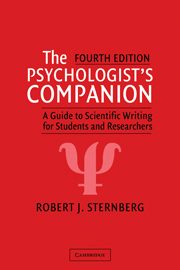Book contents
- Frontmatter
- Contents
- Acknowledgments
- Introduction
- 1 Eight Common Misconceptions about Psychology Papers
- 2 Steps in Writing the Library Research Paper
- 3 Steps in Writing the Experimental Research Paper
- 4 Rules for Writing the Psychology Paper
- 5 Using the Internet to Aid the Research Process
- 6 Commonly Misused Words
- 7 American Psychological Association Guidelines for Psychology Papers
- 8 Guidelines for Data Presentation
- 9 References for the Psychology Paper
- 10 Standards for Evaluating the Psychology Paper
- 11 Submitting a Paper to a Journal
- 12 How to Win Acceptances from Psychology Journals: Twenty-Nine Tips for Better Writing
- 13 Writing a Grant or Contract Proposal
- 14 How to Find a Book Publisher
- 15 Writing a Lecture
- 16 Article Writing 101
- References
- Appendix A Sample Psychology Paper
- Appendix B Writing for British and European Journals
- Index
11 - Submitting a Paper to a Journal
Published online by Cambridge University Press: 05 June 2012
- Frontmatter
- Contents
- Acknowledgments
- Introduction
- 1 Eight Common Misconceptions about Psychology Papers
- 2 Steps in Writing the Library Research Paper
- 3 Steps in Writing the Experimental Research Paper
- 4 Rules for Writing the Psychology Paper
- 5 Using the Internet to Aid the Research Process
- 6 Commonly Misused Words
- 7 American Psychological Association Guidelines for Psychology Papers
- 8 Guidelines for Data Presentation
- 9 References for the Psychology Paper
- 10 Standards for Evaluating the Psychology Paper
- 11 Submitting a Paper to a Journal
- 12 How to Win Acceptances from Psychology Journals: Twenty-Nine Tips for Better Writing
- 13 Writing a Grant or Contract Proposal
- 14 How to Find a Book Publisher
- 15 Writing a Lecture
- 16 Article Writing 101
- References
- Appendix A Sample Psychology Paper
- Appendix B Writing for British and European Journals
- Index
Summary
If you write a paper that you believe makes a substantial contribution to psychological knowledge, you may want to consider submitting the paper for publication. Your academic adviser or course instructor can give you advice regarding the publishability of your paper, and an appropriate choice of a journal to which to submit the paper.
DECIDING UPON A JOURNAL
If you decide to submit a paper for publication, the first step you must take is to decide upon a journal to which you want to submit the paper. Seven considerations should enter your decision:
1.Quality. Journals vary widely in quality. Some journals publish papers that do little more than fill up journal space; other journals publish only outstanding contributions to the literature. Better journals generally have higher rejection rates for submitted papers, so that the probability of a paper being accepted in such journals is lower. Your adviser or course instructor can help you match the quality of your paper to an appropriate journal.
2.Content. All journals limit by content the kinds of papers they accept. Journal editors use either or both of two criteria in deciding upon the appropriateness of a paper's content. The first criterion is substantive focus. What is the topic of research? The journal may accept, for example, only developmental, or cognitive, or applied papers. The second criterion is methodological focus. How was the research done? The journal may accept, for example, only experimental, or theoretical, or review papers.
- Type
- Chapter
- Information
- The Psychologist's CompanionA Guide to Scientific Writing for Students and Researchers, pp. 216 - 220Publisher: Cambridge University PressPrint publication year: 2003



